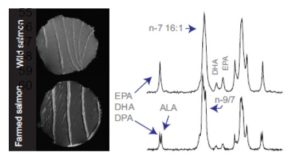Salmon in the NMR tube
Applying NMR spectroscopy and Magnetic Resonance Imaging, researchers at our department (Christian Totland, John Georg Seland and Willy Nerdal) and at Høgskulen på Vestlandet (Signe Steinkopf) document how reduction in marine omega-3 in farmed salmon affects salmon fillet features, right down at the molecular level. The study shows that carbon magnetic resonance spectroscopy direct on the fish meat can quantify the most relevant fatty acids within 40 minutes without the use of chemicals such as chloroform. In 1990, omega-3 in farmed salmon was predominantly marine fatty acids while there are now roughly equal levels of omega-3 from plants and marine sources.  MR images show differences in texture between wild and farmed salmon, where wild salmon have narrower lines of fat tissue compared to farmed salmon. In addition, the muscle tissue of farmed salmon shows buildup of fat, known as marbled fat. The softer consistency of farmed salmon can be viewed in conjunction with fat profile.
MR images show differences in texture between wild and farmed salmon, where wild salmon have narrower lines of fat tissue compared to farmed salmon. In addition, the muscle tissue of farmed salmon shows buildup of fat, known as marbled fat. The softer consistency of farmed salmon can be viewed in conjunction with fat profile.